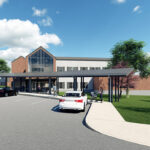Capital Region Water has put in place a comprehensive work plan to improve the health of local waterways; repair aging infrastructure and reduce combined sewer overflows; address localized flooding and stormwater runoff; revitalize neighborhoods through community greening; and meet mandatory state and federal clean water requirements.
Several measures of success already have been attained. Since 2013, Capital Region Water has invested $110.7 million on capital improvement projects, tackling critical water and wastewater needs while addressing years of deferred maintenance. A total of $315 million in investments are planned over the next 20 years as part of the City Beautiful H2O Program.
No one denies the challenges of maintaining and upgrading infrastructure that is more than a century old in some places, or in finding ways to pay for the work in a city where nearly one of every three residents lives below the poverty line. The affordability to residents needs to be part of the equation, and it has been with the plan Capital Region Water proposed.
Despite this success and these planned investments, the Environmental Integrity Project (EIP) on Aug. 22 issued a report that challenges the work of Capital Region Water and questions the innovative measures being adopted to clean up local waterways. The report contains serious flaws that make its findings deficient. Several claims need to be addressed to set the record straight:
***
MYTH: Capital Region Water is to blame for high bacteria levels and problems at City Island.
FACT: There is little correlation between bacteria concentrations at City Island, rainfall events, and combined sewer overflow (CSO) activity within Capital Region Water’s service territory. The Pennsylvania Department of Environmental Protection (DEP) assessment of Susquehanna River water quality, summarized in the 2016 Pennsylvania Integrated Water Quality Monitoring and Assessment Report, concludes that the shallow and wide physical characteristics of the Susquehanna River in the vicinity of Harrisburg limit mixing across the river. These characteristics create five parallel flow streams, where the center 80 percent of the river width is dominated by three upstream flow streams (the Susquehanna main stem, the Susquehanna West Branch, and the Juniata River). Local discharges hug the east and west banks (each approximately 10 percent of the River width). The DEP study makes clear that the river currents closest to the eastern shore do not mix with the currents along City Island. This same conclusion was reached through water quality sampling and modeling conducted in 2005 for the previous Harrisburg CSO Long-Term Control Plan. Because of these flow patterns, which are demonstrated through monitoring, bacteria concentrations near City Island often are higher than near-shore bacteria concentrations, indicating bacteria sources that affect the City Island beach, and keep it closed, are coming from upstream and not from CSO events. Interestingly, the EIP report contains no upstream or baseline water quality testing to establish the background bacteria concentrations coming from upstream.
***
MYTH: Capital Region Water actively chooses to discharge sewage vs. choosing treatment.
FACT: In a permitted combined sewer system (CSS), the same pipes that carry away sanitary sewage or wastewater from household use (such as toilet flushing and bathing) also carry stormwater from rooftops and pavement. During dry weather or light rainfall events, both stormwater and wastewater are carried to Capital Region Water’s Advanced Wastewater Treatment Facility (AWTF) for treatment before clean water is then released back into the Susquehanna River downstream of the City of Harrisburg. During moderate to heavy rainfall events, the combined system reaches volume capacity and a mixture of very dilute sewage and stormwater overflows into the Susquehanna River and/or Paxton Creek, as was intended by the system’s designer years ago. This is called a combined sewer overflow (CSO) event. Capital Region Water is responsible for 59 CSO structures in Harrisburg. Overflow events are a symptom of a 100-year-old designed combined system and not an operational choice. Capital Region Water’s Advanced Wastewater Treatment Facility is capable of treating up to 80 million gallons of wastewater each day and average flows are just above 20 million gallons each day. By rehabilitating the systems that collect and convey wastewater to resolve issues related to deferred maintenance and structural and/or maintenance deficiencies, as well as developing a Long-Term Control Plan (LTCP) to resolve capacity constraints and control the frequency, duration, and the volume of CSOs, Capital Region Water is and will continue to maximize capture and treatment at the AWTF and therefore limit the associated pollution into the Susquehanna River and Paxton Creek.
***
MYTH: Capital Region Water is not doing enough to address the issues.
FACT: No one denies the challenges of maintaining and upgrading infrastructure that is more than a century old. These problems didn’t surface overnight; they won’t be fixed overnight. To address these challenges, Capital Region Water has employed a parallel plan. One, rehabilitate the sewer system in order to catch up on decades of deferred operation and maintenance needs, including implementation of a comprehensive asset management system to ensure the sewer system continues to provide reliable service to customers. Two, implement wet weather controls to reduce combined and sanitary sewer overflows, including unauthorized releases, MS4 discharges, and eliminate backups onto streets and into basements. This includes both gray and green infrastructure. No one denies more must be done. But there is no easy solution and there is no cheap fix.
***
MYTH: Capital Region Water’s plan doesn’t spend enough to fix the problem.
FACT: Capital Region Water can only spend what its customers can afford. We have proposed $315 million in investments over the next 20 years as part of the City Beautiful H2O Program to repair aging infrastructure, address runoff and clean up waterways. A $40 million upgrade to our Advanced Wastewater Treatment Facility, finished in 2016, made it one of the most cutting-edge treatment facilities in the region, with improved operations to better protect the Susquehanna River. We’re also in the process of rehabilitating our large combined sewer interceptors and our primary pumping station to increase the volume of flow that reaches our AWTF. These are just a few examples of how far we have gone. But with all of these projects, affordability matters. Capital Region Water’s plan has defined implementation phases, with anticipated levels of CSO volume control achieved, and the estimated available level of expenditure within each phase so the authority can maintain wastewater rates at not more than 2 percent of the median annual household income within the city.
A financial capability assessment was completed in accordance with U.S. Environmental Protection Agency (EPA) requirements in order to assess the financial capability of Capital Region Water and its customers within the City of Harrisburg to pay for the plan. A high financial burden level, according to federal affordability guidelines, is expected to occur in Harrisburg when the anticipated additional capital costs are incurred by Capital Region Water over the next 10 years. However, some customers in Harrisburg are already experiencing economic hardship and affordability issues, and these conditions may worsen as capital spending continues, and rates increase in the future to support the $315 million level of spending.
The following key customer statistics highlight the limited financial capability:
- Unemployment has ranged between 14 percent and 17 percent in recent years, which has averaged approximately 10 percentage points higher than national, state, and county levels.
- Approximately 32 percent of the population is living below the poverty level, which is more than double the national, state, and county poverty levels.
- The median household income of $33,289 (in 2015) is more than $20,000 lower than that of the national, state, and county, and is only approximately $8,000 higher than the poverty threshold for a family of four.
- An estimated 25 percent of the households within the City of Harrisburg currently pay a wastewater bill that is more than 2 percent of their income, and approximately 30 percent of households have a combined water and sewer bill that exceeds 4 percent of income. Federal affordability guidelines state that there is a high financial burden when the total residential wastewater and stormwater costs reach 2 percent of the median household income (MHI).
All of these elements must be factored into Capital Region Water’s plan.
***
MYTH: Capital Region Water has avoided paying penalties or fines for CSO or other violations.
FACT: That’s not true. Capital Region Water has been assessed fines and has paid those fines in full. In lieu of more punitive fines that drain already limited resources, Capital Region Water supports investing the money back into the system to fix problems, modernize infrastructure, and hasten compliance. It is better to spend customer fees on improvements rather than penalties.
***
MYTH: Capital Region Water’s plan targets 60 percent capture.
FACT: Capital Region Water’s plan targets approximately 80 percent of CSO volume captured over the 20-year plan horizon. (In fact, the chart on Page 33 of the Overview of the full plan shows the 80 percent attainment, and that document is publicly available in Capital Region Water’s City Beautiful H2O Program Plan.) A plan that focuses on Susquehanna River water quality attainment is unaffordable over the planning horizon, estimated to cost approximately $530 million (2017 $), and would force residents out of their homes because of rates they could not afford.
***
MYTH: Capital Region Water’s plan relies too heavily on green stormwater infrastructure.
FACT: Capital Region Water evaluated the full range of CSO control alternatives, both centralized and decentralized (i.e. green infrastructure) stormwater control strategies, including deep tunnels, parallel interceptors with increased pumping and treatment capacity, an end-of-pipe satellite control strategy (i.e. large storage facilities), and a complete sewer system separation. The estimated cost of implementing these strategies approaches or exceeds $1 Billion. Decentralized strategies combining green and gray infrastructure within each of the program planning areas helps to solve existing problems regarding uncontrolled CSO discharges, significant structural deterioration, and hydraulic pinch-points presenting a heightened risk of unauthorized discharges (e.g., localized flooding and basement backups) in addition to achieving the larger goal of reducing CSO activity. Decentralized strategies such as satellite storage/treatment and green/gray water projects within neighborhoods maximize triple-bottom-line benefits and leverage non-traditional funding sources; and is the most cost-effective strategy.
Systemwide or centralized strategies do not assist in addressing collection system rehabilitation or neighborhood concerns such as basement backups or street flooding and they have the higher cost of treating the combined sewage when the treatment plant has the capacity to treat after the storm.
A decentralized (green and gray) control strategy, which is widely recognized as an effective approach, is preferred for the following major reasons:
- It is affordable and cost-effective, meeting wet weather control objectives and supporting a multitude of multi-objective benefits, with significant opportunity for public-private partnerships to share implementation costs with CRW ratepayers.
- It is flexible, installed in small, incremental investments throughout the system, using technologies that can be designed to also address unauthorized releases and integrate with sewer rehabilitation projects, and suitable for integration with a broad range of redevelopment and public works projects. Indeed, with the limited financial capabilities of CRW and the remaining uncertainty in the magnitude of collection system renewal needs, it may represent the only viable strategy to begin meaningful wet weather control.
- It is balanced, providing CRW the opportunity to invest throughout the community as well as avoid areas of excessive community impacts. It does not favor or place undue burden on any part of the community and, in fact, is designed to “lift up” the community through strategic investments that benefit water quality, public health and safety, and promote re-investment in the community.
- It builds upon the baseline level of control, with its initial focus on the rehabilitation and enhanced reliability of CRW’s AWTF and conveyance system, anticipated to provide significant wet weather control benefits within the first 10 years of program implementation, with deployment of decentralized controls in priority areas to “fill gaps” in existing system performance.
- It has community support, consistently demonstrated through public engagement opportunities, and representing the only strategy that “gives back” to the community, potentially providing ancillary economic benefits that enhance the financial capabilities of CRW and its ratepayers.
***
MYTH: Capital Region Water is not doing enough to plan for higher rainfall amounts and more significant storms resulting from climate change.
FACT: Capital Region Water continually monitors rainfall and system performance, including CSO activity. The program will adapt to the reality of climactic conditions. Planning has been prepared using the historic data that is available and will continue to adapt as trends and regulations evolve.
Charlotte Katzenmoyer is CEO of Capital Region Water.






